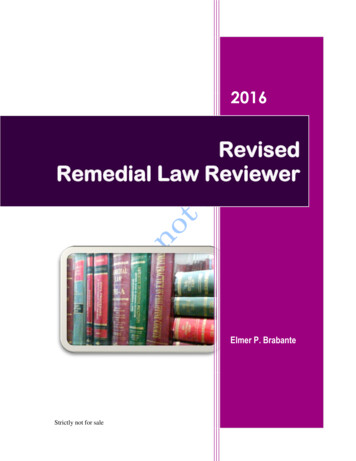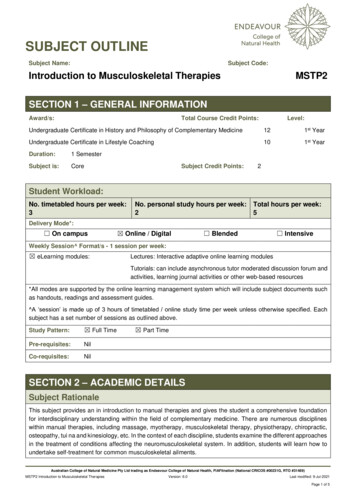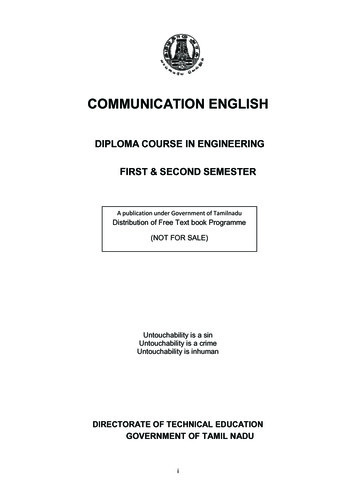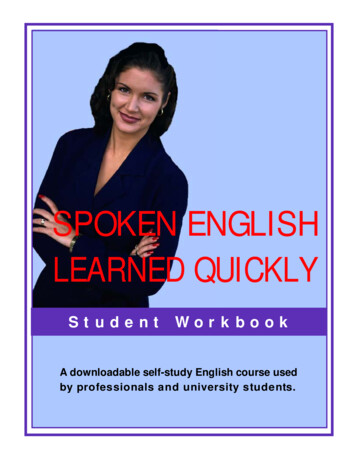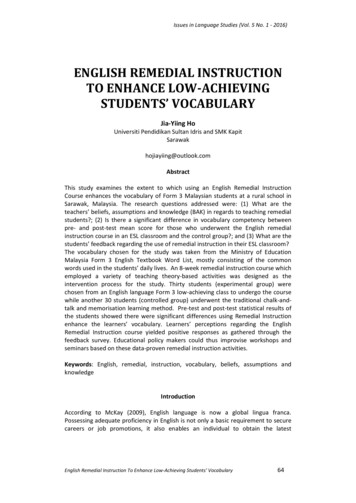
Transcription
Issues in Language Studies (Vol. 5 No. 1 - 2016)ENGLISH REMEDIAL INSTRUCTIONTO ENHANCE LOW-ACHIEVINGSTUDENTS’ VOCABULARYJia-Yiing HoUniversiti Pendidikan Sultan Idris and SMK KapitSarawakhojiayiing@outlook.comAbstractThis study examines the extent to which using an English Remedial InstructionCourse enhances the vocabulary of Form 3 Malaysian students at a rural school inSarawak, Malaysia. The research questions addressed were: (1) What are theteachers’ beliefs, assumptions and knowledge (BAK) in regards to teaching remedialstudents?; (2) Is there a significant difference in vocabulary competency betweenpre- and post-test mean score for those who underwent the English remedialinstruction course in an ESL classroom and the control group?; and (3) What are thestudents’ feedback regarding the use of remedial instruction in their ESL classroom?The vocabulary chosen for the study was taken from the Ministry of EducationMalaysia Form 3 English Textbook Word List, mostly consisting of the commonwords used in the students’ daily lives. An 8-week remedial instruction course whichemployed a variety of teaching theory-based activities was designed as theintervention process for the study. Thirty students (experimental group) werechosen from an English language Form 3 low-achieving class to undergo the coursewhile another 30 students (controlled group) underwent the traditional chalk-andtalk and memorisation learning method. Pre-test and post-test statistical results ofthe students showed there were significant differences using Remedial Instructionenhance the learners’ vocabulary. Learners’ perceptions regarding the EnglishRemedial Instruction course yielded positive responses as gathered through thefeedback survey. Educational policy makers could thus improvise workshops andseminars based on these data-proven remedial instruction activities.Keywords: English, remedial, instruction, vocabulary, beliefs, assumptions andknowledgeIntroductionAccording to McKay (2009), English language is now a global lingua franca.Possessing adequate proficiency in English is not only a basic requirement to securecareers or job promotions, it also enables an individual to obtain the latestEnglish Remedial Instruction To Enhance Low-Achieving Students’ Vocabulary64
Issues in Language Studies (Vol. 5 No. 1 - 2016)knowledge and expand horizons. The importance of English has received greatattention from the government of Malaysia and a variety of programmes have beencarried out to enhance students’ English proficiency, especially secondary schoolstudents. One of the main goals in the “Malaysia Education Blueprint (2013-2025)”issued by the Ministry of Education is to equip our students holistically to allowthem to succeed in the 21st century, with all of the opportunities and challenges thatthis new era presents (Ministry of Education, 2012, p. 8). According to the primeminister of Malaysia, Dato’ Sri Haji Mohammad Najib bin Tun Haji Abdul Razak, “it isour nation’s target to rise from the bottom-third to the top-third of the countries inthe international assessments in PISA and TIMSS in 15 years” (Mininstry ofEducation, 2012, p.9). The deputy Education Minister P. Kamalanathan stated thatthe government plans to make English a compulsory subject to pass in the SijilPelajaran Malaysia (SPM) examinations in 2016 (Rozana, 2015).Therefore, heightening students’ motivation to learn English is a greatchallenge to most English teachers, especially those serving in rural schools ofSarawak, Malaysia. This is because the majority of the students in these ruralschools come from longhouses, where the exposure to English language is limited.Background of StudyIn Malaysia, English is an important language and it is recognised as a secondlanguage in the country. Ibrahim and Mat Saman (2010) stated that English hasbeen widely utilised as a means of interaction in various fields particularlyeducation. The challenges that second language learners face in their lowersecondary school years and upon entering the upper form are enormous, specificallywhen the language of instruction is not their first language. The vocabularycompetency, in particular, represents a main concern for many low-achievingstudents who are expected to achieve the minimal Band 1 of the Form 3 EnglishLanguage School Based Assessment. In a survey of 100 teachers in Malaysia, thereappeared to be general consensus that the majority of low-achieving students lackinterest in learning and they do not understand what is being taught. These Form 3low-achieving students have a limited range of vocabulary; thus their motivation tolearn is lower. Therefore, the probability of passing the PT3 seems to be very low,which would reflect negatively on the school’s overall English subject academicperformance and this causes great anxiety to the low-achieving students. This studyserves to showcase the potential positive impacts of changing teachingmethodologies to enhance students’ vocabulary competency.The Remedial Education Program is an instructional program designed forchildren who have identified deficiencies in reading, writing and mathematics(Richards, 2015). Remedial Instruction equips teachers with in-demand skills andaddresses a very deep need within our education system. The remedial instructionactivities are simple, yet significant and do not require an excessive amount ofpreparation. Furthermore, the approaches, pedagogies and activities that arerelated to remedial instruction are suitable for the level of the remedial students.Among the teaching theories incorporated in remedial instruction are StephenKrashen’s (1989) Affective Filter Hypothesis, Howard Gardner’s (2011) MultipleEnglish Remedial Instruction To Enhance Low-Achieving Students’ Vocabulary65
Issues in Language Studies (Vol. 5 No. 1 - 2016)Intelligence, Total Physical Response (Asher, 1969), Task-Based Approach (Ellis,2004) and Language Experience Approach (Allen, 1970). Among the more distinctMultiple Intelligences incorporated in the remedial instruction course areinterpersonal, musical and bodily kinesthetic skills. As for Task-Based Approach,students are grouped in the four to carry out most of tasks in the remedialinstruction course. Each member will have a role, be it the scripter or the leader.Teacher brings students out of the classroom to experience the fun of learningEnglish through the Language Experience Approach. Students are able to relate theirdaily occurrence to English language. The main motivation of this research is toinvestigate the effectiveness of the remedial activities, learning material andworksheet used during the remedial instruction course.Purpose of StudyAs discussed earlier, the low-achieving students of a rural secondary school inSarawak face many vocabulary challenges in the usual one-size-fits-all learningenvironment. With the abundance of information and educational methodologiesavailable, adapting the methods of teaching is appropriate since remedial instructionallows more individualised and modeled learning. The introduction of the EnglishRemedial Instruction initiated by Malaysian English Language Teaching Centre is partof the initiative by Professional Learning Community under the Malaysia EducationBlueprint (2013-2025). The remedial instruction course aims to transform thelearning experience of remedial students and enable them to have a sense ofachievement while allowing these learners freedom in relation to time and content.It is believed to empower remedial students with the motivation and vocabularycompetency needed to enrich their learning experience. The remedial instructiondoes not aim to replace existing student-centered methods. It, however, attemptsto provide English language teachers with an alternative approach to teachingEnglish vocabulary in ESL classrooms. It aims at heightening the motivation of lowachieving learners and further engage these learners in the remedial instructionactivities, thus fostering more learner autonomy.The objective of the research is to determine the effectiveness of using RI toenhance low-achieving students’ vocabulary. Based on the objective of this study,three research questions are addressed:1) What are the teachers’ beliefs, assumptions and knowledge (BAK) in regardsto teaching remedial students?2) Is there a significant difference in vocabulary competency between pre- andpost-test mean score for those who underwent the English remedialinstruction course in an ESL classroom and the control group?3) What are the students’ feedback regarding the use of remedial instruction intheir ESL classroom?English Remedial Instruction To Enhance Low-Achieving Students’ Vocabulary66
Issues in Language Studies (Vol. 5 No. 1 - 2016)MethodologyThe participants in this study consisted of two categories, 100 teachers serving inMalaysia and 60 Form 3 remedial students (24 male and 36 female) from a ruralsecondary public school which is only accessible via a 3-hour express boat ride inSarawak. Almost half (49%) of the teachers had three to 10 years of teachingexperience.For the first research question, “What are the teachers’ beliefs, assumptionsand knowledge (BAK) in regards to teaching remedial students?”, an online surveyconsisting 10 questions (refer to Appendix A) were sent to teachers in Malaysia viathe social media, Facebook. The Survey Monkey (SM) software was used to designthe online survey and the data gathered were analyzed in the form of graphs andstatistics.To answer the second research question, “Is there a significant difference invocabulary competency between pretest and posttest mean score for those whounderwent the English remedial instruction course in an ESL classroom and thecontrol group?”, 30 of the 60 students were selected as the experimental groupwhere they were exposed to Remedial Instructions course for eight weeks. Theother 30 students were the control group who learned vocabulary through thetraditional method of chalk-and-talk. An English remedial instruction course wasadapted (see Appendix B) to suit the learners’ needs by incorporating theories likeMultiple Intelligences, Affective Filter Hypothesis, Task Based Approach, TotalPhysical Response and Language Experience Approach. The focus was on improvingstudents’ competency in vocabulary. Pre-tests and post-tests (see Appendix C) onvocabulary were given and the same sets of questions were used in order to find outthe improvement of students’ performance. The vocabulary test was pilot tested on15 students for validity and reliability purposes and minor modifications were madebefore allowing the control and experimental groups to sit for the test.For the experimental group, students underwent the 8-week remedialinstruction course three days a week, 70 minutes for two days and 35 minutes forthe other day. The total instruction time was 20 hours and 40 minutes. Theobjectives, instructions to carry out the lessons, and suggested list of vocabularywere stated in the remedial instruction course outline.For the third research question, “What are the students’ feedback regardingthe use of Remedial Instruction in their ESL classroom?” a questionnaire entitled‘Teachers’ Beliefs towards Teaching Low-achieving Students’ was formulated. Thequestionnaire consisted of 10 questions measured on a five point Likert-type Scale(see Appendix D) were distributed to the experimental group to explore theeffectiveness of the remedial instruction course. The online questionnaire was pilottested on 15 teachers from Kapit district before it was used for the actual study. 100teachers in Malaysia voluntarily participated in this online survey. There were morefemale respondents (65.31%) than male respondents (34.69%).This research was a single-phase, 8-week study, employing quantitativemethods. A mix-typed survey instrument was used to analyse the teachers’ beliefs,assumptions and knowledge towards teaching low-achieving students and a pre-English Remedial Instruction To Enhance Low-Achieving Students’ Vocabulary67
Issues in Language Studies (Vol. 5 No. 1 - 2016)post vocabulary test was carried out for the student-participants, followed with aLikert-type scale survey for the students’ feedback.Results and DiscussionTeachers’ Beliefs, Assumptions and Knowledge in regards to Teaching RemedialStudentsBased on Table 1, 74 respondents felt that teaching low-achieving studentswas challenging while 16 respondents felt that teaching this target group wasenjoyable. Four respondents did not have any particular feelings towards teachingremedial students whereas the remaining six respondents differed in opinions.Among the six responses, three teachers expressed negative feelings on teachinglow-achieving students. Some of the words they used were “frustrating”, “stressful”and “challenging and heart-breaking” while the other two stated positively that itwas “rewarding” and “enjoyable and challenging”. The 6th teacher was neutral,stating “depend on the (students’) discipline too”.Table 1Percentage of responses with highest percentage for teachers’ beliefs, assumptionsand knowledgeItem1234Aspects of beliefs, assumptions andknowledgeFeelings of teaching low-achievingstudentsChallenges faced in teaching lowachieving students5Belief that learning should be funBelief that learners have differentlearning stylesBelief that learning should be:6Belief that standardized tests are:7Belief on teachers’ patience andstudents’ motivation improveacademic performanceResponseswith ents arenot interestedin learningStrongly agreeStrongly agree79.00learnercentereddoing moregood thanharmYes75.0056.0054.0054.0879.80In Item 2, respondents were given a choice to tick more than an answer. Thebiggest challenge faced by teachers in teaching low-achieving students was thatstudents were not interested in learning, followed by students did not understandwhat was being taught. The other challenges faced were insufficient experience toEnglish Remedial Instruction To Enhance Low-Achieving Students’ Vocabulary68
Issues in Language Studies (Vol. 5 No. 1 - 2016)attract students’ attention in class (37%), insufficient knowledge to prepare suitableteaching materials (28%), and insufficient time to prepare teaching materials (25%).On the other hand, 7% of the respondents did not feel challenged in teaching lowachieving students. The other 11 responses were as follows:1. “Not enough time to deal with them (no streaming), they need perhaps“one-to-four” kind of attention.”2. “No self-motivation in learning. No basic foundation. Do not want to try.”3. “Students are all in different proficiency level.”4. “They do not feel that learning in school is useful for them.5. A big gap of proficiency level among the low achievers.”6. “Parents don’t really care about education of their children.”7. “Students low motivation and aspiration to study.”8. “Too lazy.”9. “Teachers don’t know the right methods to motivate students who have lowself-esteem.”10. “Too burden with other workload such as disciplinary work.”11. “The only aim for them (students) is getting married.”The results for Item 3 showed that most of the respondents agreed thatlearning should be fun; 56 respondents chose “strongly agree” and 33 respondentschose “agree” whereas 82 participants viewed learning as fun. Four respondentsremained neutral and the remaining 14 respondents disagreed that learning is fun.For Item 4, 93 respondents agreed that learners had different learningstyles. Nonetheless, there are 7 respondents who strongly disagreed with thisstatement.It was observed for Item 5, 75 respondents believed that teaching should belearner-centered while five respondents held the belief that teaching should beteacher-centered. On the other hand, the remaining 20 respondents believed thatteaching should be a mixture of both teacher- and student-centered approaches.For Item 6, the teachers were divided in their beliefs on whetherstandardised tests were doing more harm than good (45.92%). Over half of theteachers believed otherwise (54.08%). Two respondents skipped this question.For Question 7, 79.80% of 100 respondents agreed that as long as teacherswere patient and students were motivated to study, these low-achieving studentswould improve academically. Nonetheless, there were 19.19% of the respondentswho were half-hearted and 1.01% chose a definite “no”. One participant did notanswer this question.The results on teachers’ beliefs, assumptions and knowledge showed that amajority of the teachers are hopeful that low-achieving students can improveacademically through remedial instruction. This is supported by Taylor (1992) whoemphasised Language Experience Approach can help literacy learners such asremedial students to relate their experience to a teacher or aide, who can help totranscribe them. Remedial students will learn more effectively once their affectivefilters are lowered as they enjoy the activities that are achievable for them. It is theEnglish Remedial Instruction To Enhance Low-Achieving Students’ Vocabulary69
Issues in Language Studies (Vol. 5 No. 1 - 2016)sense of achievement in the students that will indirectly motivate teachers toprepare more task-based and learner-centered activities.From the results obtained from the online surveys with teachers, it ispossible to deduce that low-achieving students are equally important and should benot sidelined by teachers. Teachers play an important role in exploring variouseffective methodologies in engaging this group of learners in the classroom. Manyteachers, especially the new and young teachers find teaching remedial students agreat challenge and frustrating as they lack the patience and experience in teachinglow-achieving students. This could be supported by Gardner’s (2011) MultipleIntelligences theory in which every individual has their strength in different areas. Aslong as teachers can identify their students’ strength, they can prepare lessons oractivities which are engaging and effective for the low-achieving students. VanUden, Ritzen and Pieters (2013) stated that student engagement is an importantcondition for positive outcomes at school. Van Uden et al’s survey in Netherlandsshowed that teachers who rated themselves higher on self-efficacy, interpersonalteacher behavior and importance of pedagogical and didactic competence perceivedtheir students as more engaged in learning.Comparison Between the Pre- and Post-test Mean Scores of the Control andExperimental Groups of StudentsFigure 1. Comparison between students who passed the pre-test and post-test forthe control and experimental groupThe passing marks were set at 50%. Based on Figure 1, there are moreimprovements in the post-tests as compared to their pre-tests for both control andexperimental groups. One candidate passed in the pre-test for control group whilethere are three passes for the experimental group. In the post-test for the controlEnglish Remedial Instruction To Enhance Low-Achieving Students’ Vocabulary70
Issues in Language Studies (Vol. 5 No. 1 - 2016)group, three students from the control group passed but 10 from the experimentalgroup passed. This shows that the treatment of remedial instruction is effective forthe experimental group.The findings of this study are compatible with the theoretical assumptions ofcognitive language learning and the role of Task Based Language Learning in SecondLanguage Acquisition (Saville-Troike, 2012). After analysing the 8-weeks remedialinstruction vocabulary pre-test and post-test results, it is clear that the treatmentperformed better than the control group. The remedial instruction activities wereengaging as every student in the class were involved in all the activities carried out.Students in the treatment group had to concentrate throughout the course as theycould be randomly chosen by the teacher to answer questions. Furthermore, theywould not want to disappoint their team members as group competitionsencouraged positive competitions. In addition, the style of teaching based on RIencouraged the students to ask questions when they encountered difficulties ordoubts in understanding the new vocabulary.As stated in the research of Butler (2011), students learned most effectivelywhen they were taught in a communicative setting. The improvement in thestatistical results showed that remedial instruction, which was especially tailored forthese remedial students, worked successfully for them as they felt a sense ofachievement when they were able to complete a simple task which was within theircapability. Hands-on activities were proven to be engaging as these weak learnershad short attention span. Continual exposure which tapped their other multipleintelligences, such as kinesthetic intelligences, interpersonally intelligences andspatial-visual intelligences successfully attracted their interest in learning English.These arguments could be supported by Tomlinson (2011) and Gardner (2011)whose theories yielded positive results in incorporating task-based approach andtapping to students’ multiple intelligences to enhance students’ learning process. Asemphasized in Krashen’s (1989) Affective Filter hypothesis, when students’ affectivefilters are lowered, learning takes place more easily.Experimental Group’s Feedback on the Use of Remedial InstructionThe survey results in Table 2 indicated that students showed positive responses withregards to the use of remedial instruction to enhance their vocabulary competence.Based on Table 2, the activities that students liked in descending order ofpreference are games (86.7%), acting and hands-on activities (80%), pictureslabelling (73.4%), alphabets-stringing (66.7%), flash cards (63.3%), word-listing (60%)and songs (46.7%). The students did not like learning words using newspaper articles(40.1%). Finally, since the class has a weak command of vocabulary and presumablyalso grammar, only 36.7% admitted that they could construct meaningful sentences.Thus, teachers can adopt the effective remedial instruction activities such as bingoand paper-scissor-stone games for their students as games and hands-on activitiesare perceived as more effective by the students.Based on these results, it can be concluded that the low-achieving studentslearnt best when their affective filters were lowered. Without fear but eagerness inattempting more remedial instruction activities, these participants had overcomeEnglish Remedial Instruction To Enhance Low-Achieving Students’ Vocabulary71
Issues in Language Studies (Vol. 5 No. 1 - 2016)their ESL barrier and lowered their guard to allow learning to take place. Therefore,the data collected from the participants’ feedback supported (1989) Affective Filtertheory.Table 2Experimental group’s feedback on the use of remedial instructionSCALEITEMS1I learn new wordsthrough pictureslabeling.2I learn new wordsthrough songs.3I enjoy learning newwords by acting themout.4I enjoy learning newwords through flashcards.5I remember the newwords throughnewspaper articles.6I remember the newwords through handson activities.7I can list the new wordswith other words thatare related to them.8I can form new wordsfrom a string ofalphabets.9I can use new words toform meaningfulsentences.10 I find learning newwords fun and engagingthrough using lydisagreePercentages of Students 30.043.316.73.373.413.310.003.3Constructing meaningful sentences and reading newspaper articles wereleast favored by the participants because those tasks were deemed more dauntingas compared to fun-filled tasks like singing songs and playing games. This argumentwas supported by Tomlinson (2011) who highlighted the advantages of task-basedEnglish Remedial Instruction To Enhance Low-Achieving Students’ Vocabulary72
Issues in Language Studies (Vol. 5 No. 1 - 2016)approach in allowing learners to experience the language in ways used in the “realworld” outside the classroom. As for acting out which was a form of Total PhysicalResponse, Bowen (2013) stated that it is a teaching approach which is based, firstand foremost, on listening and is linked to physical actions which are designed toreinforce comprehension of particular basic items. Therefore, when the lowachieving students could achieve the Task-Based Approach and Total PhysicalResponse activities, they felt a sense of achievement and this eventually led them tolower down their affective filters. As proven by researchers on vocabulary learningby EFL secondary school learners, games are advantageous and effective in learningvocabulary (Aslanabadi, 2013). Thus, vocabulary games promote real world contextinto the ESL classroom, and this enhance the low-achieving students’ vocabulary in aflexible and communicative way.From the findings in the participants’ feedback regarding the remedialinstruction course, it could be inferred that there are some potential weaknessesinherent in it. Firstly, from a practical point of view, it is highly unlikely that even themost skilled and inventive teacher could sustain having lessons involvinginstructions, physical responses and outdoor experiences for more than a fewlessons before the activity becomes repetitious for the learners, although the use ofgames could provide a range of contexts for practicing a wider range of lexis.Secondly, it is fairly difficult to manage the class once they are outside of theclassroom, so the language input is basically restricted to those who stick close tothe teacher. Thirdly, the relevance of some of the language used in remedialinstruction activities to real-world learner needs is questionable. Finally, movingfrom remedial instruction games such as “Rock-Paper-Scissor” might be workable ina small group of remedial learners but it would appear to be problematic whenapplied to a class of 30 students, for example.In defense of the remedial instruction course, however, it should beemphasised that it was never intended by Malaysia Ministry of Education thatremedial instructions should extend beyond remedial students. In addition, a coursedesigned around remedial instruction principles would not be expected to followthis remedial instruction course exclusively, and the researcher herself suggestedthat remedial instruction should be used in association with other methods andtechniques. Short RI activities, used judiciously and integrated with other activitiescan be both motivating and linguistically purposeful. Careful choice of useful andcommunicative language at beginner level can make remedial instruction activitiesentirely valid. In terms of the theoretical basis for the approach, the idea of utilisingthe most effective activity that works for these remedial students resembleselements of Krashen’s (1989) Natural Approach. Many learners respond well tokinesthetic activities and they can genuinely serve as a memory aid (Bowen, 2013).A lot of classroom warmers and games are based, consciously or unconsciously, onTask-Based Approach, Total Physical Response, and Language Experience Approach.Based on the findings from students’ responses on the questionnaire, it wasfound that a considerable number of participants felt more motivated because theyexperienced a greater sense of achievement and confidence during their Englishlessons. Learner autonomy is best identified in students in their heightenedconfidence and active classroom participation. This finding was not reflected onlyEnglish Remedial Instruction To Enhance Low-Achieving Students’ Vocabulary73
Issues in Language Studies (Vol. 5 No. 1 - 2016)through the questionnaire but also through their improved results, and it is found tobe consistent with Holec (1981) and Smith (1995) who place learners in the centre oftheir learning, which is enhanced by the English remedial instruction. Past research(Leake & Lesik, 2007) holds that learners today highly appreciate task-basedactivities, and this remedial instruction in general increases student-centeredness,motivation, confidence and vocabulary enhancement.ConclusionIn Malaysia, Professional Learning Community is actively carried out throughout theschools in Malaysia, with remedial instruction being a small yet significant programwhich caters especially to low-achieving students. With the mounting pressures forteachers to increase the school’s overall academic performance, the remedialinstruction course has emerged as an effective tool especially for rural schoolswhere English is seen as a foreign language. The present study showed that remedialinstruction improved the low-achieving students’ vocabulary competency during the8-week study. Future research can conduct remedial instruction over a longer periodof time to study its effects.Insights gained through this study will provide educational leaders withquantitative data regarding educators’ beliefs, assumptions and knowledge ofeducators and the results of the pre-test and post-test can assist in providing aquantitative view of the importance of implementing this course to more schools,which, ultimately, influences students’ learning outcomes. Furthermore, theseresults may change the manner in which changes are implemented at the districtand state levels.The results of this research have implications for those at the federalgovernment, state and district levels who are looking at the remedial instructionmodel as one to be adopted. Adopting one course over another might not be theproper way for schools to continue to grow with the challenges presented toeducators to ensure the success and preparation of our remedial students. It issuggested that individuals at the state and district levels utilise theory and datadriven research results before advocating for one individual approach. Schools arecontinually faced with increas
English Remedial Instruction To Enhance Low-Achieving Students [ Vocabulary 65 knowledge and expand horizons. The importance of English has received great attention from the government of Malaysia and a variety of programmes have been carried out to enhance students English
